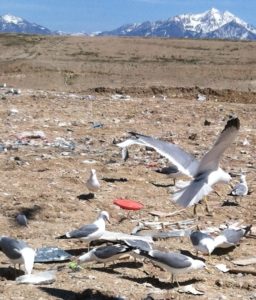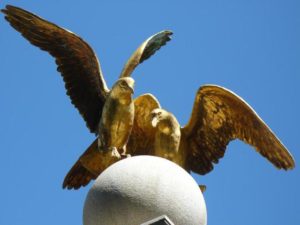In 1955, Utah legislators named the “Sea Gull” the state bird. They were commemorating the 1848 “Miracle of the Seagulls,” when huge flocks of gulls ate up hoards of crickets, saving crops of the newly landed Mormon pioneers.
This is funny on two counts:
- As Mainers know, there’s no such thing as a “sea gull.” The gull they honor is, in fact, the California Gull, one of four dozen species in the subfamily of gulls. Back home, we have plenty of Herring Gulls and Black-Backed Gulls. “Look at the sea gulls!” is something tourists say.
- There was no Miracle of Gulls, either. Mormon researchers have found little or no references to the phenomenon during the time it is said to have occurred.
“Nowhere is mentioned any instance of a spectacular crop rescue by cricket-eating seagulls,” writes the Mormonism Research Ministry.
Gulls, do, however have a long and storied connection to trash. We took a trip to the Trans Jordan landfill the other day.
Gulls, gulls everywhere!
Though not one for superlatives, I must say I’ve never, ever, in my entire life seen so many gulls in one place. Utah’s state bird, rarely seen elsewhere, has a huge presence at dumps. And dumps have a huge presence in Utah.
 For starters, the state population is booming (increasing by 40,000 annually) and everyone’s trash has to go somewhere.
For starters, the state population is booming (increasing by 40,000 annually) and everyone’s trash has to go somewhere.
Secondly, recycling is not integrated into the folks’ mindsets or municipal mandates.
“I think we Utahns still have a Western frontier attitude,” my realtor told me when I asked why there was so little recycling.
A friend added, “a large percentage of the population here thinks that climate change is a liberal hoax…and that God created the earth so that man could trash it. “
According to Trans Jordan landfill site, less than 15 percent of Salt Lake Valley trash is recycled (less than half of the national average). Not coincidentally, trash production well above the national average. Utahns generate more than a ton per capita per year, reports a national study.
Heck, Maine isn’t exactly a shining example of sustainability, but it recycles six times more trash than Utah, generating nearly a million tons less trash.
Maine’s state bird is the chickadee, which likes to flit around trees. Maine has plenty of trees.
Utah has plenty of trash…
Now I get it!
The selection of gull as state bird wasn’t a nod to Mormon myth. It was a prophetic gesture.



We need to look at ourselves here in Utah. We overpopulate, over eat, polute the valley and fail to sustain what we have. Shame on us. If it continues maybe we should change the state bird to the Dodo bird.
The state bird, as a study pointed out a few years ago, also has the same rate of homosexuality as occurs among humans. If that fact were more widely known in this state, they would either have to change state birds or revise their notions of “natural” marriage.
Growing up in Utah we were not taught that the “Sea Gull” is the state bird. It was always the California Gull.
I grew up in NH and have lived in UT for 7 yrs. I see the California gull everywhere even ME. The logical thing is every human should take better care of the world and we might call that bird by it’s rightful name instead of a seagull that eats trash…